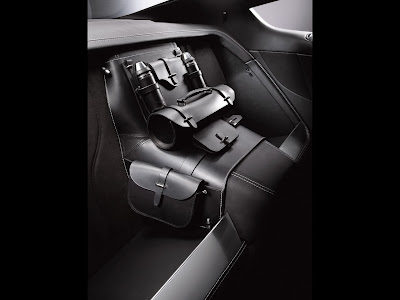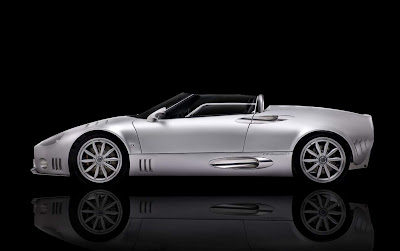 Aston Martin will unveil one of the most eagerly anticipated cars of the year when the new DBS is revealed at the Pebble Beach Concours d’Elegance on August 16th, where the company takes a starring role as the featured marque.
Aston Martin will unveil one of the most eagerly anticipated cars of the year when the new DBS is revealed at the Pebble Beach Concours d’Elegance on August 16th, where the company takes a starring role as the featured marque. Aston Martin Chief Executive Officer, Dr Ulrich Bez, said: “The DBS is the ultimate expression of Aston Martin’s engineering and technical ability. It offers pure performance without compromise.
Aston Martin Chief Executive Officer, Dr Ulrich Bez, said: “The DBS is the ultimate expression of Aston Martin’s engineering and technical ability. It offers pure performance without compromise. “The DBS delivers the complete driving experience and bridges the gap between our road and track cars – the DB9 and DBR9.”Equally at home on a twisting mountain circuit as on the open road, the DBS is a true thoroughbred.
“The DBS delivers the complete driving experience and bridges the gap between our road and track cars – the DB9 and DBR9.”Equally at home on a twisting mountain circuit as on the open road, the DBS is a true thoroughbred.The need for high-performance stability, handling ability and low kerb weight defined the DBS’s form and construction. Accordingly, the DBS becomes the first production Aston Martin to make extensive use of ultra-light carbon-fiber body panels.
 These include a ‘by-pass’ engine air intake port that opens above 5500 rpm to allow more air into the engine, and re-profiled air inlet ports that further improve airflow into the combustion chamber.
These include a ‘by-pass’ engine air intake port that opens above 5500 rpm to allow more air into the engine, and re-profiled air inlet ports that further improve airflow into the combustion chamber. Combined with a compression ratio of 10.9:1, the result of these enhancements is prodigious power and torque: the DBS delivers 510 bhp at 6500 rpm. The 3.71:1 final-drive ratio ensures that the additional power is usable, enhancing in-gear acceleration in particular.
Combined with a compression ratio of 10.9:1, the result of these enhancements is prodigious power and torque: the DBS delivers 510 bhp at 6500 rpm. The 3.71:1 final-drive ratio ensures that the additional power is usable, enhancing in-gear acceleration in particular. As an option the DBS may be equipped with specially developed lightweight seats (outside North America). These feature a carbon-fiber and Kevlar composite structure and are manufactured by a supplier to the motorsport and aviation industries before being returned to Aston Martin’s Gaydon factory for hand-trimming.
As an option the DBS may be equipped with specially developed lightweight seats (outside North America). These feature a carbon-fiber and Kevlar composite structure and are manufactured by a supplier to the motorsport and aviation industries before being returned to Aston Martin’s Gaydon factory for hand-trimming. The structure is created by sandwiching a layer of Kevlar between two layers of carbon-fiber with the outer finish left exposed on the seat backs, lacquered to create a durable and attractive finish.
The structure is created by sandwiching a layer of Kevlar between two layers of carbon-fiber with the outer finish left exposed on the seat backs, lacquered to create a durable and attractive finish. The start sequence of the DBS is augmented by an all-new centre console design with a cast metal surround, crisp typography and new graphics. The new console has a traditional dial-face clock at the centre, flanked by two rotary controls for the heating and air-conditioning system, fashioned from solid, turned aluminum.
The start sequence of the DBS is augmented by an all-new centre console design with a cast metal surround, crisp typography and new graphics. The new console has a traditional dial-face clock at the centre, flanked by two rotary controls for the heating and air-conditioning system, fashioned from solid, turned aluminum. Deliveries of the DBS are expected to commence during quarter one 2008, with prices to be confirmed at the Frankfurt Motor Show in September.
Deliveries of the DBS are expected to commence during quarter one 2008, with prices to be confirmed at the Frankfurt Motor Show in September. The external detailing reflects the power and dynamic abilities of the DBS, with revised inlets and enlarged grilles that deliver more air into the engine and increase its cooling capacity.
The external detailing reflects the power and dynamic abilities of the DBS, with revised inlets and enlarged grilles that deliver more air into the engine and increase its cooling capacity. Subtle design details include a new five-bar design for the polished alloy main grille, as well as two additional vents in the enlarged power bulge on the carbon-fiber bonnet. These vents are entirely functional, improving engine performance and efficiency, yet also communicating the increased power output of the uprated V12 engine.
Subtle design details include a new five-bar design for the polished alloy main grille, as well as two additional vents in the enlarged power bulge on the carbon-fiber bonnet. These vents are entirely functional, improving engine performance and efficiency, yet also communicating the increased power output of the uprated V12 engine. The DBS’s aerodynamic enhancements are shaped by Aston Martin’s racing experience. A carbon-fiber splitter and a new front bumper design help channel airflow around the car’s wider bodywork.
The DBS’s aerodynamic enhancements are shaped by Aston Martin’s racing experience. A carbon-fiber splitter and a new front bumper design help channel airflow around the car’s wider bodywork. The aerodynamics team worked hand in hand with the modeling team to ensure that the forms and surfaces of DBS were sculpted for inherent stability at high speeds.
The aerodynamics team worked hand in hand with the modeling team to ensure that the forms and surfaces of DBS were sculpted for inherent stability at high speeds.












































